Why to Build a Two-Sided Marketplace: Benefits and Challenges
Summarize:
If you had to explain the concept of a two-sided marketplace in one sentence to your grandma, what would you say? Probably something like this:
A two-sided marketplace is an online platform that connects individual sellers or service providers with their clients.
Okay, that was probably not that hard. But what if your granny goes further and asks, “Why would someone build such a marketplace?” Then you will have to show her this article. This is exactly the topic we cover: why to choose a two-sided marketplace business model.
Benefits of creating a two-sided marketplace
Your grandmother has definitely heard about services like Uber or Airbnb. Most likely she is an active user of eBay or even sells her knits on Etsy. So she knows how this model works, but a look behind the scenes will bring some great insights. Not just to the granny, but to you too.
So why do people start creating a two-sided online marketplace platform?
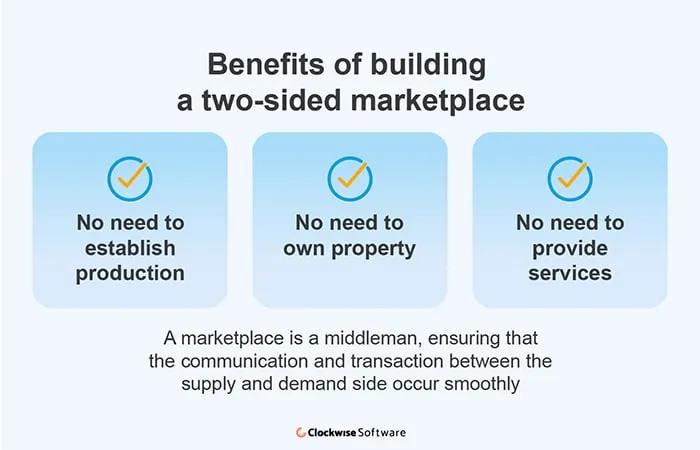
- No need to establish production
Etsy sells millions of hand-made items yearly online without producing anything. It connects the people who create with the ones ready to buy these products. - No need to own property
Airbnb operates in 100,000 cities all around the globe without owning a single apartment. It connects people who want to rent their property with the ones who are looking for a place to stay when on the way. - No need to provide services
Fiverr offers services of dozens of various professionals and none of them work for the company. Fiverr just connects freelancers with companies that are in need of such services.
These are the most successful two-sided marketplace businesses. And they are all middlemen for online transactions. Its main task is to ensure that the communication and transaction itself occur smoothly and that both parties have their benefits.
But if you (or your grandma) think that running a two-sided marketplace business is a piece of cake, get ready for some discoveries. Trying to satisfy two different audiences turns out to be harder than it seems at first. However, there’s no challenge that can’t be solved.
Two-sided online marketplace platform challenges and how to overcome them
There are challenges that are common for every type of software business. For example, most entrepreneurs struggle to write their first business plan, and they also have no idea how to fund their startup. It is also quite hard to choose a monetization model. Luckily, we have already covered these topics in our previous articles (don’t miss the links).
In this article, we discuss the challenges that exclusively the founders of two-sided marketplace platforms have to face.
Chicken and egg problem
It doesn’t matter how hard we try to hide the actual problem with metaphors, you definitely know what we are talking about. Buyers and sellers, whom to attract first?
It will be hard to get thousands of consumers when your online platform offers just a few products or services. At the same time, sellers aren’t motivated to post their offers unless they see a real demand for their products.
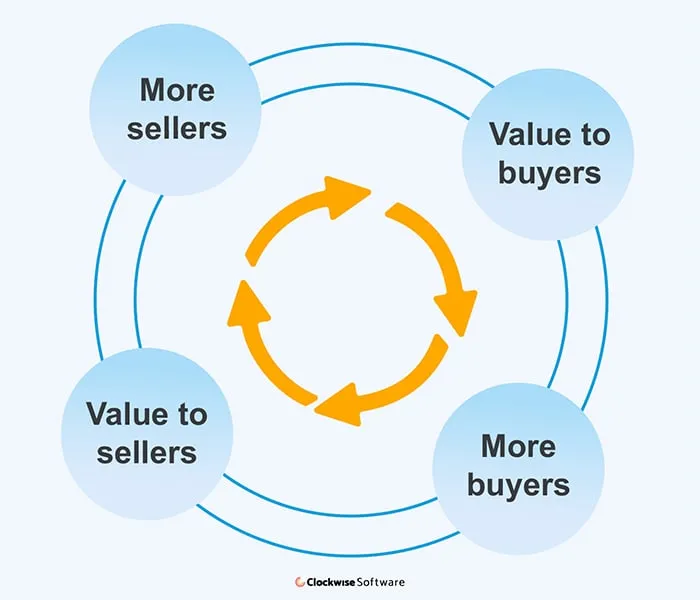
Think of a marketplace as a grocery store. If a buyer enters the store and sees empty shelves, he leaves immediately.
And what about the suppliers? In most cases, they are ready to wait for the consumers to come. They see the potential benefit and accept this short-term risk.
Now, let’s return to two-sided marketplaces.
- You are looking for an apartment in New York. You visit Airbnb, but there are no offers. Would you return to Airbnb later?
- You are in a hurry and need a taxi. You open the Uber app, but there are no cars available near you. Would you try again later?
Consumers have an urgent need and they want it to be covered ASAP. If they don’t find the solution on your website, they go to your industry competitor.
Sellers and service providers, on the contrary, are looking for a stable and long-term relationship.
So the conclusion is: ensure the supply first. When the first consumers come, they have to see the variety of products and services offered. This makes them come back in the future and recommend your service.
What features help attract buyers and sellers?
Our business analyst will provide you with a free consultation concerning your individual business case
Centralized vs. decentralized marketplace business model
There are two types of platforms:
- the ones that just help the consumer and seller find each other online
- the other ones, which take over all the management of the transaction between two parties
The decentralized marketplaces let the customer do everything by himself: discuss the details, negotiate the price, transfer money, and ship the product, etc.
This is what eBay does. It lets you into a huge marketplace with millions of offers. Anyone can sell anything for any price. Buyers and sellers can discuss the transaction, shipping, or exchange of goods. And this approach is okay for them.
Another group is centralized platforms - the ones that make most of the job for you.
Just like Uber does. You don’t have to enter your address, don’t choose the driver, you don’t negotiate the price, even the transaction occurs automatically. All you do is hit the “Request a ride” button. Then the magic occurs.
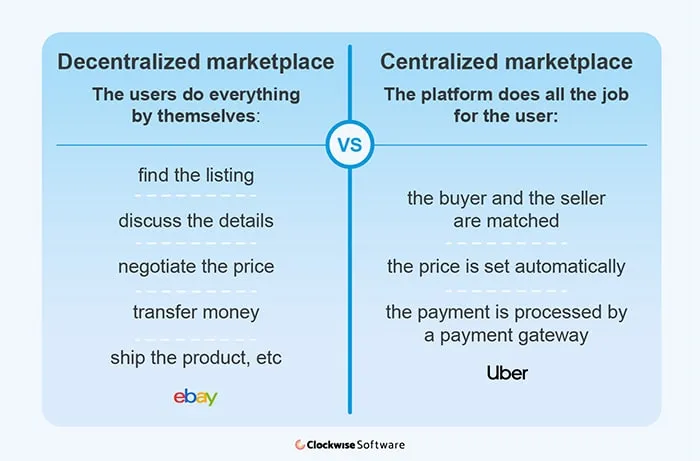
Which of these approaches will fit your case? Well, it depends on so many circumstances.
The general rule is: the more expensive the product or service, the more control over the online transaction the consumer wants to have: look through all the photos, read the reviews, chat with the seller.
If the need is urgent and the price is not that high, the consumer is ready to trust the selection and processing to the platform.
Centralized two-sided marketplaces greatly save time. But when choosing this approach you’ll face another challenge.
Curation
When a consumer comes to a renowned marketplace platform, his expectations are high. He does not just want a wide selection of products online, he wants a wide selection of high-quality products and first-class service. In other words, he expects that you have already removed not-so-good items and under-average sellers.
That’s why most of the e-commerce apps and platforms in the industry set the default sorting of listings to “recommended.” This means that the customer sees the “better” listings first. These may be the ones with better price, more positive reviews, or the ones that include photos of higher quality. This is called curation.
By being a curator for your customers, you make sure that they see the best offers first, which reduces the chance of being disappointed by poor service or low quality.
There are two approaches to curation in a two-sided marketplace business model:
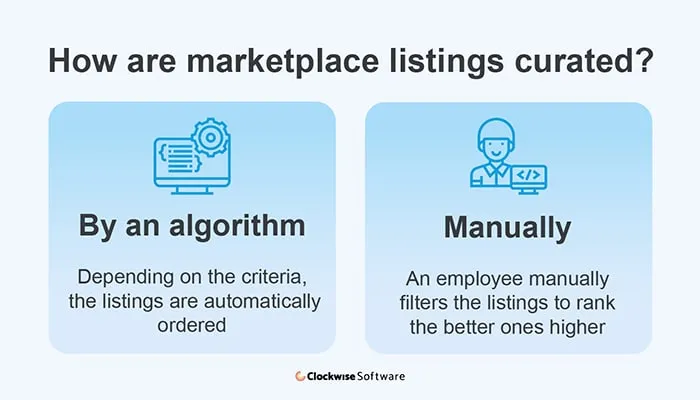
- Employ an algorithm
The software can analyze an array of listings, putting them in a certain order. Moreover, after analyzing the behavior of the customer, this algorithm can show the listings that are more likely to satisfy their preferences first. - Curate manually
Sometimes, humans do better than software. Let your employees create lists of top listings for different categories according to various criteria such as a sense of humor of the seller (works for freelancer platforms, for example) or the best window views, if your platform focuses on vacation apartments.
By providing curation, you don’t make the decision for your customers. Instead, you help them make the right choice faster, eliminating the need to filter poor listings.
Be the first to reach liquidity
The sellers and service providers that come to your online platform expect that they will sell their product or service quickly. The consumers expect that they will be able to find exactly the product or service they were looking for. When the balance between the expectations of buyers and sellers is met, you reach liquidity.
Imagine that you want to sell a floor lamp you no longer need. Where do you go? eBay!
What if you want to buy a cheap floor lamp? eBay, again.
Both consumers and providers know that they will achieve their goal on this platform.
The first platform that reaches liquidity is very hard to beat. eBay used to have dozens of competitors back in the 2010s. And you can barely remember the names now.
Some countries have their local platforms to sell used stuff online. But there is always one top player that has the majority of transactions.
If you enter an industry that is not that busy yet, you are lucky. You have a chance to be the first to reach liquidity and conquer the market for the coming years. Yes, that’s challenging. But it is worth it.
How we built a two-sided marketplace at Clockwise Software
A marketplace development company has a handful of benefits, including the chance to work in various spheres. It’s all about learning, experiments, and new experiences.
Recently our team was creating a two-sided marketplace platform and we have some insights worth sharing:
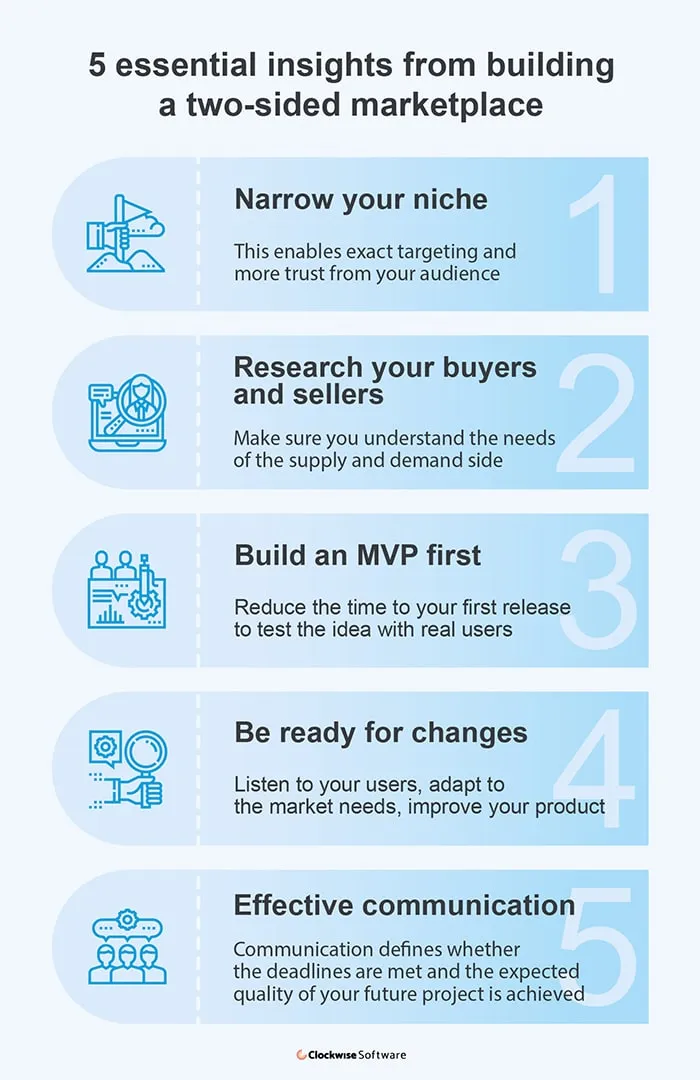
- Narrow your niche
Instead of building an app for nannies, you can create a babysitting app like Uber. That’s what Zūm did. They connect busy parents with babysitters that can drive their children to school, meet them after classes, bring them to a dancing class, etc.
Why is focusing that important? The narrower your targeting, the more trust you get. The easier it is for you to reach your audience. Become the #1 player in your industry and then you will be ready for expansion. - Know you, consumers and providers,
We have already mentioned that running a two-sided platform means working with two completely different audiences. And you have to make sure you study both groups before you move to the development process.
When building Toddy, our two-sided platform for babysitters, we have focused on app development for iOS. After release, we had very few signups from nannies. Our research showed that the majority of potential babysitters were using budget Android smartphones, so we had to develop an app for Google Play Market. Luckily, we were using a hybrid app development approach. - Start with an MVP
Building a full-feature native app with custom design and seamless interaction takes years. You may be ready to wait, but the industry is not. The demand is likely to change, and your competitors can fill the market with their offers. You risk releasing a perfect product that is no longer needed.
Instead, make the path from idea to market as short as possible. A minimum viable product concept is what you need at this stage to test the concept with minimum cost to build a marketplace. Take a few weeks to build a basic version of your product and start testing it with real customers. Listen to them, analyze, improve. This strategy helped us to release Creadoor - the marketplace for photo and video creators - in a short time. - Be ready to make changes to your initial idea
The market is cruel. Sometimes it turns out that your idea isn’t what customers actually need. The good news is that you found it out early. Just be ready to adjust your idea so that it corresponds with what the customers expect.
Toddy started as a two-sided marketplace for parents and individual babysitters, but the highest demand came from babysitting agencies. We had to adjust the functionality and create some new features to meet our new target audience. Now it works much better! Just keep in mind that changes are inevitable. - Don’t neglect communication
One of the mentioned startups came to Clockwise Software after having a negative experience with freelance developers. Indeed, remote cooperation with multiple contractors affects online communication. The development process is slower, mistakes occur more often, and you spend more and more time managing your team of freelancers.
The solution is having the whole team in one office. You can hire the professionals full-time, but this will be overkill - you spend too much money and other resources. Software development outsourcing, on the contrary, gives you financial flexibility combined with seamless communication and good working quality.
Conclusion
Two-sided marketplaces rock. Right now, the world’s most successful consumer companies are marketplaces. There’s barely an industry that doesn’t have its own Uber.
Why do we love such platforms? A marketplace gives each transaction a personal touch.
During my last trip to Barcelona, I booked an apartment on Airbnb. My host asked me to bring a postcard from my hometown. As a welcome gift, we were granted a bottle of local wine. Then within half an hour we were talking about some hidden gems of the city, restaurants for locals, etc. In the end, the host told me I can call her anytime I come to Barcelona, whether it is for a glass of sangria or a weekend stay.
Can you imagine bringing a postcard for a receptionist in a hotel chain?
Globalisation makes us value personal communication. That’s why more and more people will prefer buying on two-sided marketplaces from individual producers or service providers rather than companies.
What does it mean? Peer-to-peer platforms are booming. And you can jump into this business until the competition gets really tight. And we have even prepared a detailed how-to guide for you: 4 steps to build a successful two-sided marketplace platform.
Searching for personal advice considering your business case?
Discuss your idea with our business analyst and have all your questions covered!

Any questions unanswered?
Let's discuss them
